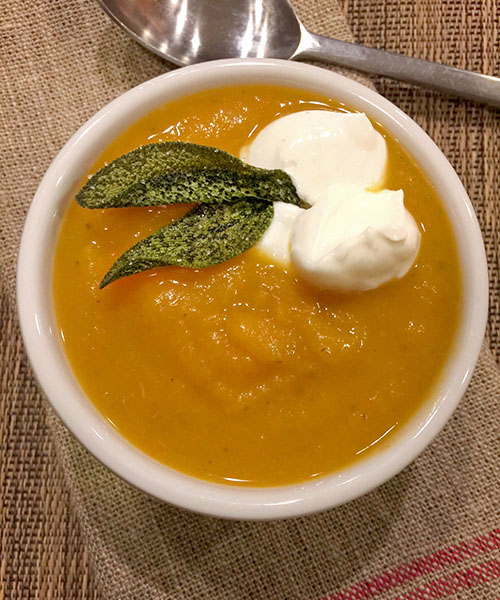
[T]ime gets away from us. It was fall, and I looked up and it was almost winter! Before fall closes (and even after the season has turned), I wanted to express an appreciation for butternut squash — namely in soup. Early in autumn, a friend brought me a container of soup made with this magic squash, along with onions, celery and apples, which gave it a note of sweetness. It was puréed to a fine, creamy consistency. And when she gave it to me, my friend — who is a cook to the point of seemingly being able to run her own restaurant, and who frequently brings me her dishes to try — commented, “You cook all the time, I don’t know why I bring you food.†Ha!
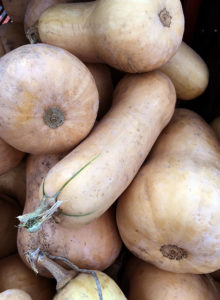
[E]ven though she was right, one woman’s butternut squash (or pork buns, wild rice or pumpkin bread) is another woman’s treasure. Her bringing me that soup was a gentle reminder that it’s always better when someone else makes it, and, so few people do make and give me food, whether they believe I’ll judge, or they are not generous with their cooking or they think I simply don’t need it. But I do! I do need my friend Anna’s creations. Her food is wonderful, and her sharing it is a true gift from the heart.
But she’s right, I could — and would — make my own butternut squash soup.
[T]here are recipes aplenty out there for butternut squash soup. Anna offered me the one she used to make the soup she gave me, but I also stumbled across one by the famed chef Thomas Keller that I could not get out of my mind…one simple ingredient in that recipe won me over — sage. The idea of one of my most favorite aromatic herbs flavoring a creamy, buttery soup was irresistible.
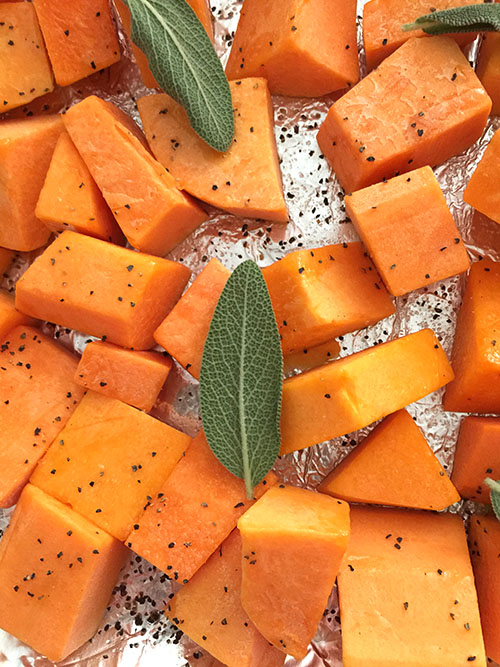
[I] took a few liberties with Keller’s recipe, one of them being with the butternut squash. Having wrestled with a whole butternut squash before — peeling, cutting, de-seeding, cubing — I decided to avoid that whole process and take advantage of the already prepped squash (cut into perfect cubes) available in the markets. I oiled, salted and peppered this squash, laid out onto a foil-lined sheet pan — and roasted it until tender.
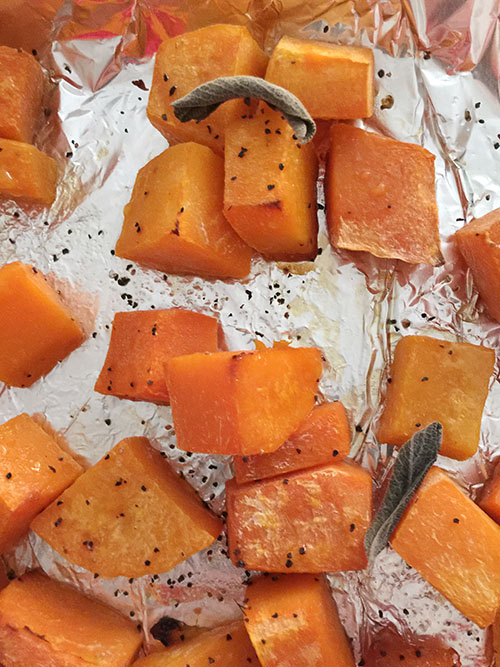 [T]he recipe called for part of the fresh squash to be left un-roasted, and aded to the carrots, shallots, leeks, onion and garlic to be sautéed on the stovetop. I figured this might be a strategy to layer flavor into the soup (as roasting and sautéing do different things to veggies). Honey is added during this process for another layer — of sweetness
[T]he recipe called for part of the fresh squash to be left un-roasted, and aded to the carrots, shallots, leeks, onion and garlic to be sautéed on the stovetop. I figured this might be a strategy to layer flavor into the soup (as roasting and sautéing do different things to veggies). Honey is added during this process for another layer — of sweetness
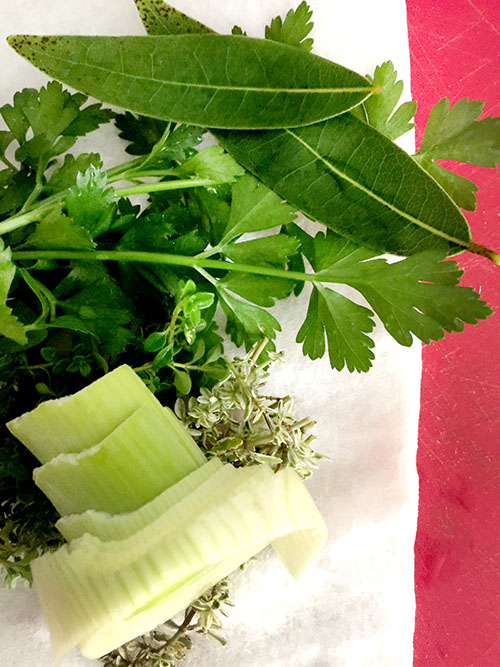 [S]tock and a “bouquet garni†made up of herbs, including thyme, and the green part of the leeks is also put into the soup.
[S]tock and a “bouquet garni†made up of herbs, including thyme, and the green part of the leeks is also put into the soup.
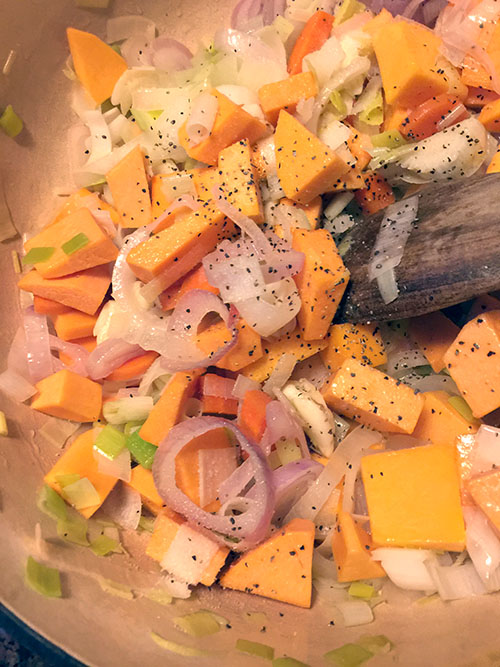
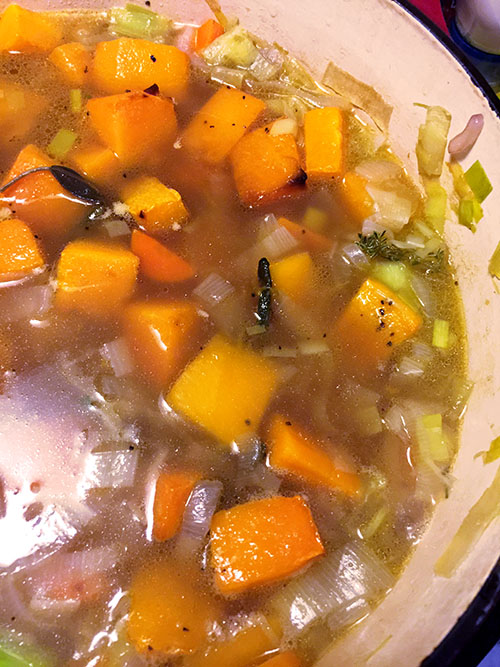 [T]he roasted squash is added and all is allowed a 30-minute simmer time to fully incorporate and meld all the flavors. I amended the instructions to blend the cooked soup in batches in the blender and just used my inversion blender instead…this wonder tool did the job just fine to purée the soup.
[T]he roasted squash is added and all is allowed a 30-minute simmer time to fully incorporate and meld all the flavors. I amended the instructions to blend the cooked soup in batches in the blender and just used my inversion blender instead…this wonder tool did the job just fine to purée the soup.
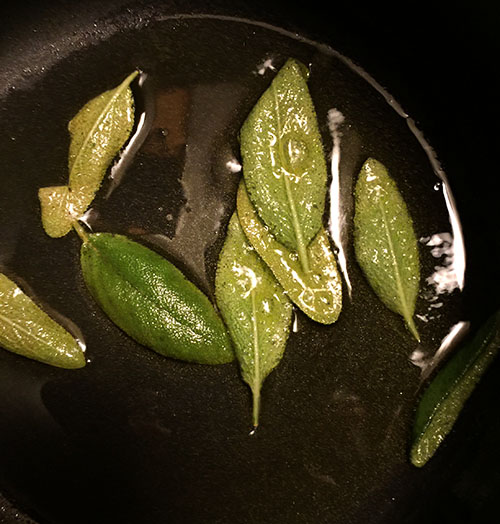
[A]fter mixing up a topping of sour cream with a little nutmeg (the recipe called for creme fraiche, but I could not find any in the store), I worked on the simple garnish of magic sage leaves, fried to a delicate crispness in browned butter.
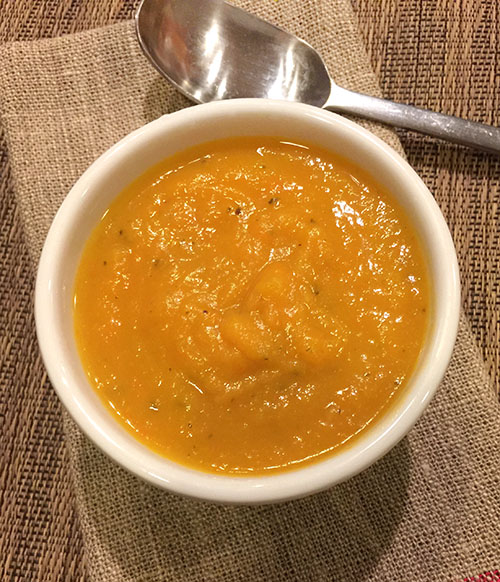
[T]his golden soup hit the spot (and even had me considering wrangling with a whole butternut squash again). It was hearty and satisfying, but light, and the more I ate, I was treated to a tasting of layer upon layer of flavor. In the future, I might even share some with Anna.
Thomas Keller’s Butternut Soup
with Brown Butter, Sage, and Nutmeg Crème Fraiche
From Food52 (www.food52.com)
Serves 6
1 3 to 3 1/2-pound butternut squash
2 tablespoons canola oil
1 pinch Kosher salt and freshly ground black pepper, plus more to taste
2 sprigs sage
1 cup thinly sliced (1/8-inch thick) leeks, white and light green parts
only
1/2 cup thinly sliced (1/8-inch thick) carrots
1/2 cup thinly sliced (1/8-inch thick) shallots
1/2 cup thinly sliced (1/8-inch thick) onions
6 garlic cloves, peeled and smashed
2 tablespoons honey
6 cups vegetable stock, plus extra if necessary
8 sprigs thyme, 2 sprigs Italian parsley, 2 bay leaves, and 1/2 teaspoon
black peppercorns, all wrapped in a bouquet garni packet made of 2 green leek leaves
4 tablespoons (2 ounces) unsalted butter
1/4 cup crème fraîche
1 pinch Freshly grated nutmeg
Canola oil (if using sage leaves)
1 tablespoon minced chives or 12 sage leaves
1 pinch Kosher salt and freshly ground black pepper, plus more to taste
1 splash Extra virgin olive oil, to garnish
For the soup: Preheat the oven to 350° F. Line a small baking sheet
with aluminum foil or parchment.
Cut the neck off the squash and set it aside. Cut the bulb in half and
scoop out and discard the seeds. Brush each half inside and out with
about 1 1/2 teaspoons of the canola oil. Sprinkle the cavities with salt
and pepper and tuck a sprig of sage into each. Place cut side down
on the baking sheet and roast for about 1 hour, or until completely
tender.
Remove the squash from the oven and let cool, then scoop out and reserve the flesh (discard sage).
Meanwhile, using a paring knife or a peeler, carefully peel away the skin from the neck of the squash until you reach the bright orange flesh. Cut the flesh into 1/2-inch pieces (you should have about 4 cups).
Put the remaining canola oil in a stockpot over medium-high heat, add the leeks, carrots, shallots, and onions and cook, stirring often, for about 6 minutes. Add the diced squash, garlic, 1 1/2 teaspoons salt, and 1/2 teaspoon pepper and cook gently for 3 minutes, reducing the heat as necessary to keep the garlic and squash from coloring.
Stir in the honey and cook, stirring, for 2 to 3 minutes. Add the stock and bouquet garni, bring to a simmer and cook for 10 to 15 minutes or until the squash is tender.
Add the roasted squash and simmer gently for about 30 minutes for the flavors to blend. Remove from the heat and discard the bouque garni. Transfer the soup to a blender, in batches, and puree. Strain the soup through a fine sieve into a bowl. Taste the soup and adjust the seasoning. Let the soup cool, then refrigerate until ready to serve.
To complete: Place the crème fraiche in a chilled small metal bowl and stir in nutmeg to taste. Whisk with a small whisk until the crème fraiche holds a shape. Cover and refrigerate.
Reheat the soup. If it is too thick, add a little more vegetable stock. Heat a medium skillet over high heat. When it is very hot, add the butter and rotate the skillet over the heat as necessary to brown the butter evenly, scraping up any bits that settle in the bottom. As soon as the foaming has subsided and the butter is a hazelnut brown, pour it into the pot of soup. Be careful not to leave the butter over the heat too long, as it can change from rich brown to black in seconds.
Meanwhile, if using sage leaves, heat 1/8 inch of canola oil in a small skillet. When the oil is very hot, add the sage and cook for 30 to 45 seconds, turning the leaves to crisp them on both sides. When the bubbling stops, the moisture in the leaves will have evaporated and the leaves will be crisp. Drain the sage on paper towels and sprinkle with salt.
Ladle the soup into six serving bowls. Top each with a dollop of crème fraiche. Grind some black pepper over the top and garnish each with 2 sage leaves or some minced chives. Drizzle a little olive oil over the top.